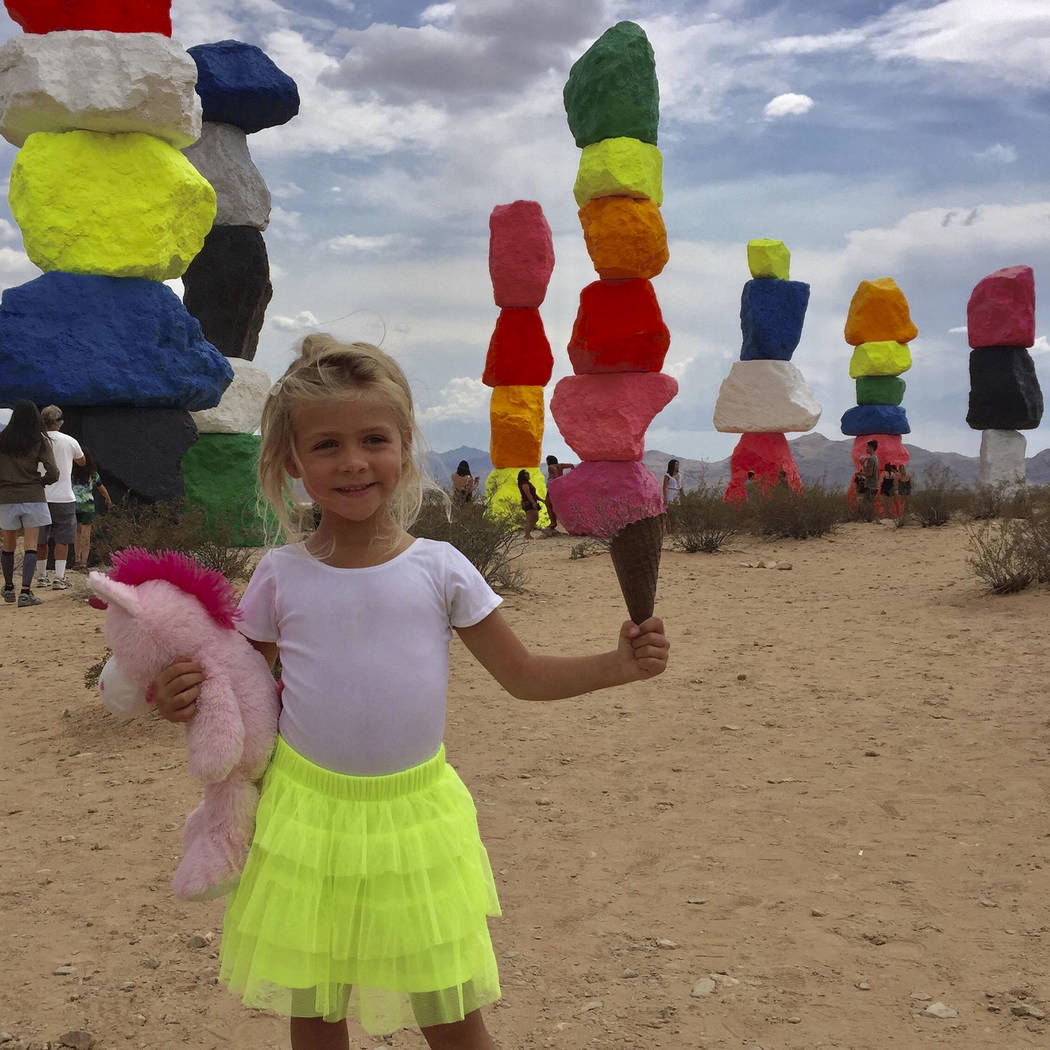‘Seven Magic Mountains’ gaining international attention on social media
Technically, artist Ugo Rondinone’s “Seven Magic Mountains” doesn’t celebrate its first anniversary until May 7.
But “it’s always a celebration” at the towering, neon-hued land art project south of Las Vegas, according to Casey Fremont, executive director of the Art Production Fund, which produced “Seven Magic Mountains” with Reno’s Nevada Museum of Art. “From day one, it has exceeded our expectations.”
In part, she attributes that to the fact that it’s “an especially accessible artwork. In public art, it’s important that everyone can relate to it.”
Or, as NMA executive director David Walker notes, “it’s not a requirement that you know a lot about art to fall in love with the piece or to be moved by it.”
Rondinone’s sculpture was five years, and more than $3 million, in the making — first at Las Vegas Paving Company’s quarry near Apex, where the boulders were prepared, and then between Sloan and Jean, where the totems were installed 10 miles south of the Las Vegas Boulevard-St. Rose Parkway intersection.

Since “Seven Magic Mountains’ ” May 2016 debut, the installation — a smaller Stonehenge with a Day-Glo paint job — has attracted up to 1,000 people a day, according to Walker.
“Often with projects like this, you see a leveling out of interest and visitation,” he says. But not so far.
“We weren’t anticipating this,” he adds, noting that the state tourism commission values the project’s overall media exposure at $7 million — a million a mountain.
Impromptu visits require no advance notice or permission — unlike a recent 10-page spread in the fashion bible Vogue, which required a special permit to use “Seven Magic Mountains” as a backdrop for a showcase of similarly multihued handbags.
“We’ve been very careful not to host or allow many things” of that nature, he adds. “The magic is for the people who have made a drive” to see “Seven Magic Mountains” and “spend a half-hour or an hour” amid its towering 25- to 35-foot totems, painted in eye-popping hues that provide maximum contrast with the surrounding desert.
“People have engaged and interacted with the sculptures,” Fremont points out. And not just in person.
On social media, visitors have posted photographs of “Seven Magic Mountains,” often adding their own personal touches — from body-paint inspired by its Day-Glo colors to paintings of the stacked boulders.
“It’s a real testament to the power of public art,” in Fremont’s view.
A monthly Instagram contest (Rondinone’s idea, she says) showcases the best “Seven Magic Mountains” photos.
The artist “definitely likes that people are engaging (with) and posting” their reactions to his work, according to Fremont. “He’s aware of everything.”
With its stacked, vividly painted rocks visible from Interstate 15, “Seven Magic Mountains” exerts a definite attraction for motorists who pull off the road to investigate, Walker notes.
“It has a shamanistic quality,” he observes. “You’re moved by it — and you’re not sure why you’re moved by it.”
The general visitor reaction: “ ‘It’s much cooler and much larger than I imagined,’ ” he reports. “The only complaint we’ve gotten is” from those expecting “a kind of spiritual, contemplative” experience “and are a little annoyed that there were 200 other people there.”
The project has another year to run at its current location.

Although there have been “overtures from major collectors who are interested in acquiring it and moving it to the East Coast or Asia,” Walker says, Rondinone “would very much like to see it stay in Las Vegas.”
NMA officials “also believe it should stay in Las Vegas,” he adds. Although certain “we can get a special use permit to extend” the run at its current location, which is controlled by the Bureau of Land Management, “we’re looking at relocating it to Symphony Park,” in downtown Las Vegas, adjacent to The Smith Center.
“We have a year where we’re exploring what’s next,” Walker says. “I think we’re going to find a way.”
Contact Carol Cling at ccling@reviewjournal.com or 702-383-0272. Follow @CarolSCling on Twitter.
The day 'Hella Spiders' struck 'Seven Magic Mountains'
On the day artist Ugo Rondinone celebrated the debut of his "Seven Magic Mountains" project, south of Las Vegas, he expressed confidence that visitors to the artwork "will embrace and will protect" it — and not just because of a layer of anti-graffiti paint.
He hoped that "Seven Magic Mountains" would be like such public icons as "the Eiffel Tower or (Mount) Rushmore," he said at the time. "You don't see graffiti on Rushmore. People are proud of what they have."
But less than a month after its official unveiling, vandals struck, scrawling profanity, "666," genitalia and other phrases and symbols — including "Hella Spiders" — across several of the limestone boulders.

"It was like getting the first dent in your new car," says David Walker, executive director of Reno's Nevada Museum of Art, which produced "Seven Magic Mountains" with the New York-based Art Production Fund.
The damage was repaired right away and, "most important, it doesn't interfere with people experiencing the piece," says Casey Fremont, APF's executive director. "If someone has made the pilgrimage, that's sad."
After the initial vandalism, Nevada Highway Patrol officers regularly patrol the "Seven Magic Mountains" parking lot, Walker says. And there have been no more vandalism incidents at what Fremont describes as "a civic gift."
Walker doesn't expect that there will be.
"I think the community has just fallen in love" with "Seven Magic Mountains," he says. "I don't think people are going to allow it."

























